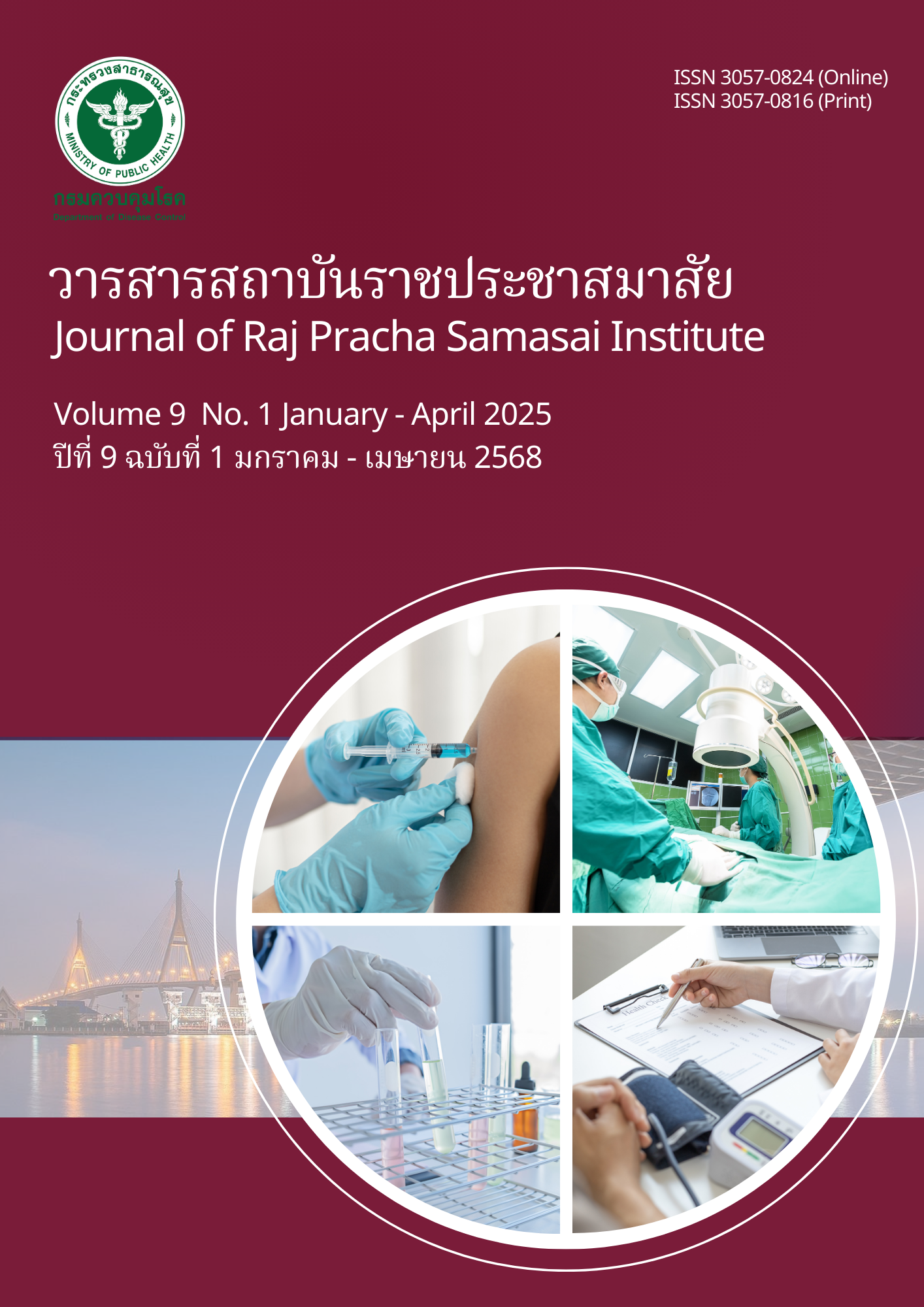An Outbreak Investigation of Influenza in Novices and Novice Attendants at a Summer Buddhist Novice Ordination Camp in A temple, Pathum Thani Province, Thailand, from 1 - 30 April 2023
Main Article Content
Abstract
Background: On 19 April 2023, the Pathum Thani Provincial Public Health Office was notified by Pathum Thani Hospital that five novices participating in the ordination ceremony had developed influenza-like illness. Nearly 5,000 novices participated in the ordination ceremony during 1 to 30 April 2023, at a temple. Other participants also had symptoms suggestive of influenza. The Pathum Thani Provincial Public Health Office conducted an outbreak investigation and implemented prevention and control measures in collaboration with the organizing committee of the temple from 21 to 25 April 2023. This study aimed to share the case report for prevention and control the outbreak and recommendation.
Methods: This quantitative epidemiological study applied descriptive and inferential statistics. Medical records of patients infected with influenza virus, presented at the temple were reviewed and the patients were interviewed at-risk individuals to identify additional patients based on the case definition of influenza. A case-control study (1 : 2 ratio) was conducted to identify risk factors for influenza infection. Four activities were compared: 1. Participating in activities at a training site, 2. Participating activities in the exhibition hall, 3. Watching movies in a 3D screening room, and 4. Participating a circumambulation ceremony (ordination). Laboratory tests and environmental studies were conducted.
Results: During 3 to 30 April 2023, 327 individuals infected influenza. Of these, 308 were novices (attack rate 6.95%) and 19 were novice attendants (attack rate 4.37%). No staff member infected, and no death was reported. The highest number of cases was in range of 10-14 years old. The study found that participating in activities within the affected training site was significantly associated with illness. The other three activities (exhibition hall, 3D movie screening, and circumambulation ceremony) were not associated with the outbreak. RT-PCR testing identified influenza A (H3N2) virus. Environmental studies found that although the temple had separated the 10 training sites to prevent contact, novices could still travel between sites and participate in activities with novices from other sites. Conclusion and discussion: This influenza outbreak was caused by the influenza A (H3N2) virus. The risk factor for disease transmission was participating in activities with the affected site. Future events should be designed to prevent contact between novices from different training sites.
Downloads
Article Details

This work is licensed under a Creative Commons Attribution-NonCommercial-NoDerivatives 4.0 International License.
ประกาศเกี่ยวกับลิขสิทธิ์
บทความที่ลงพิมพ์ในวารสารสถาบันราชประชาสมาสัย ถือว่าเป็นผลงานทางวิชาการหรือการวิจัย และวิเคราะห์ตลอดจนเป็นความเห็นส่วนตัวของผู้นิพนธ์ ไม่ใช่ความเห็นของกรมควบคุมโรค ประเทศไทย หรือกองบรรณาธิการแต่ประการใด ผู้นิพนธ์จำต้องรับผิดชอบต่อบทความของตน
นโยบายส่วนบุคคล
ชื่อและที่อยู่อีเมลที่ระบุในวารสารสถาบันราชประชาสมาสัย จะถูกใช้เพื่อวัตถุประสงค์ตามที่ระบุไว้ ในวารสารเท่านั้น และจะไม่ถูกนำไปใช้สำหรับวัตถุประสงค์อื่น หรือต่อบุคคลอื่นใด
References
Pediatric Infectious Disease Society of Thailand (TH). Winter Illnesses Part 1: Colds and Flu [Internet]. Bangkok. Pediatric Infectious Disease Society of Thailand; 2023 [cited 2023 August 24]. 1 p. Available from: https://www.pidst.or.th/A289.html.
Mahidol University, Faculty of Tropical Medicine. Annual epidemic Influenza (Flu) [Internet]. Bangkok. Faculty of Tropical Medicine, Mahidol University; 2023 [cited 2023 August 24]. Available from: https://www.tm.mahidol.ac.th/th/tropical-medicine-knowledge/new/Influenza.html
Centers for Disease Control and Prevention (US). Influenza (Flu) How Flu Spreads [Internet]. Atlanta. Centers for Disease Control and Prevention, National Center for Immunization and Respiratory Diseases (NCIRD); 2022. [cited 2022 Aug 24]. 1 p. Available from: https://www.cdc.gov/flu/about/disease/spread.htm
Coburn BJ, Wagner BG, Blower S. Modeling influenza epidemics and pandemics: insights into the future of swine flu (H1N1). BMC Medicine. 2009;7(30):1-8.
The Johns Hopkins University. Influenza (Flu) in Children [Internet]. Baltimore. The Johns Hopkins University; n.d. [cited 2022 Aug 24]. Available from: https://www.hopkinsmedicine.org/health/conditions-and-diseases/influenza/influenza-flu-in-children
Hallmann-Szelińska E, Łuniewska K, Szymański K, Kowalczyk D, Sałamatin R, Masny A, Brydak L. B. Virological and Epidemiological Situation in the Influenza Epidemic Seasons 2016/ 2017 and 2017/2018 in Poland. Adv Exp Med Biol. 2020:1251:107-113. doi: 10.1007/5584_2019_454.
Aungkulanon S, Cheng PY, Kusreesakul K, Bundhamcharoen K, Chittaganpitch M, McCarron M, et al. Influenza-associated mortality in Thailand, 2006-2011. Influenza Other Respir Viruses. 2015;9(6): 298-304 doi: 10.1111/irv.12344
Peek K. Flu Season Never Came to the Southern Hemisphere [Internet]. New York. Scientific american, A division of springer nature america; 2020 [cited 2022 Aug 24]. Available from: https://www.scientificamerican.com/article/flu-season-never-came-to-the-southern-hemisphere1/
Division of Epidemiology (TH), Development of the Surveillance System for Communicable Diseases subdivision. Report on the Situation of Influenza in Thailand; June 11-17, 2023 Available from: https://ddc.moph.go.th/uploads/ckeditor2//files/DOE_flu_24.2566.pdf
Department of Disease Control (TH), Division of Epidemiology. Case definition for Communicable Diseases Surveillance, Thailand. Nonthaburi: Division of Epidemiology; 2020.


